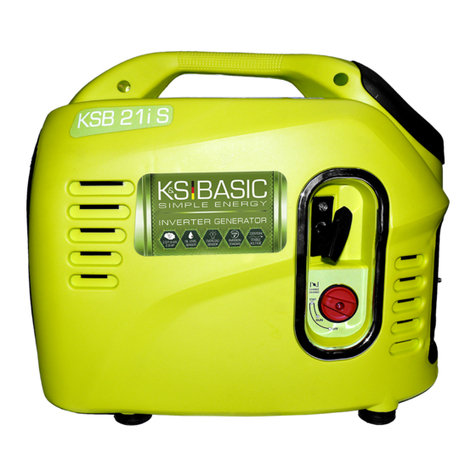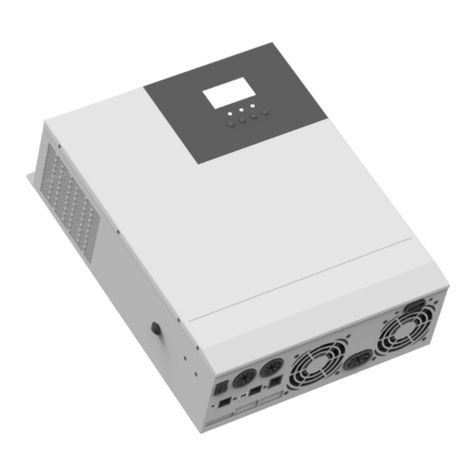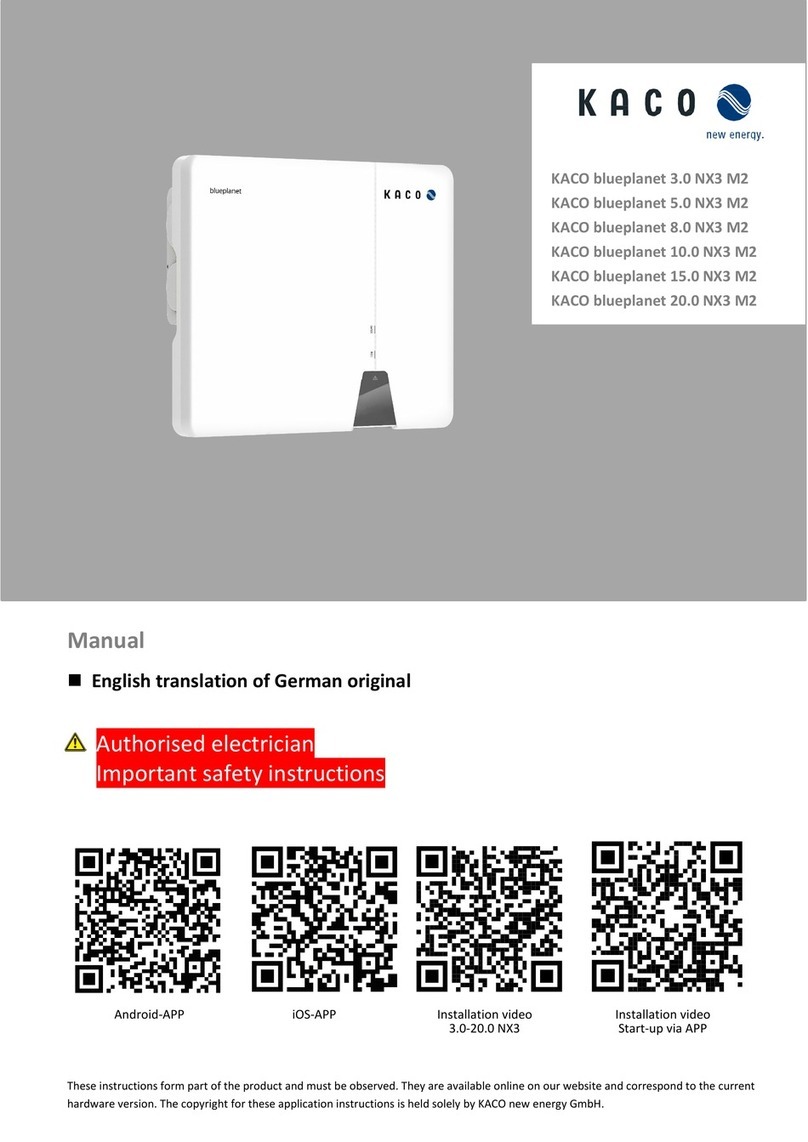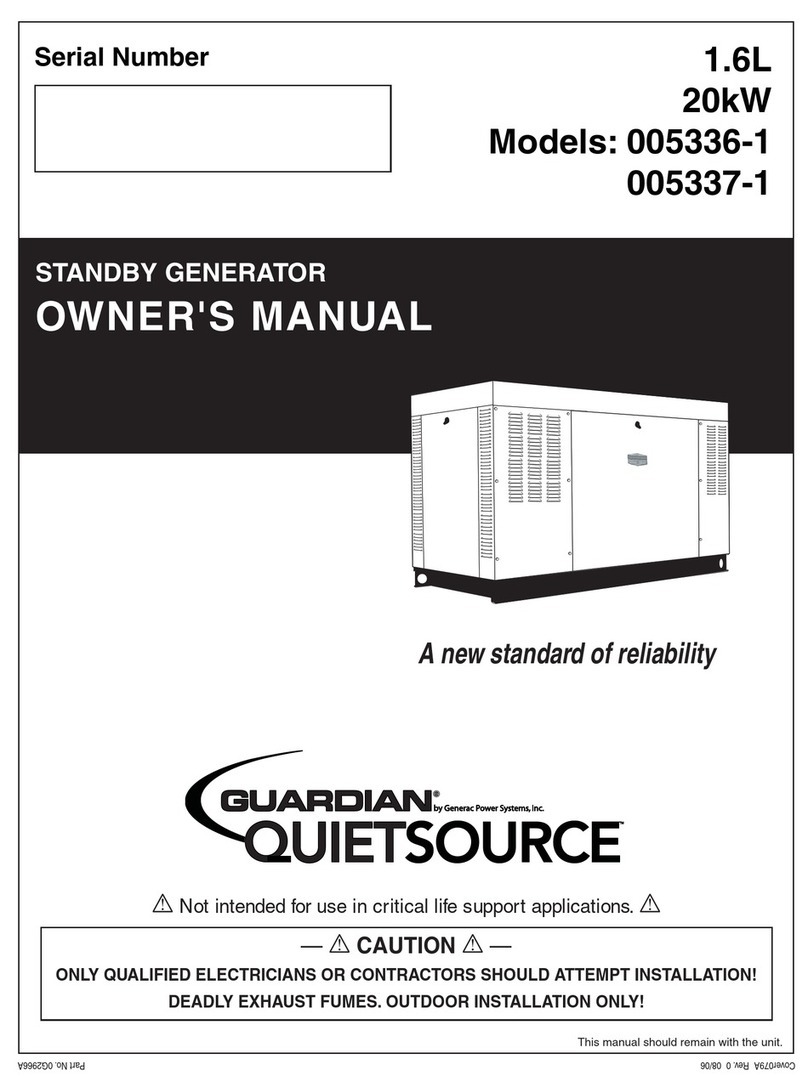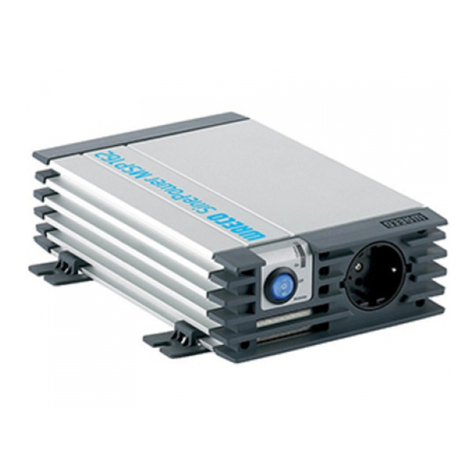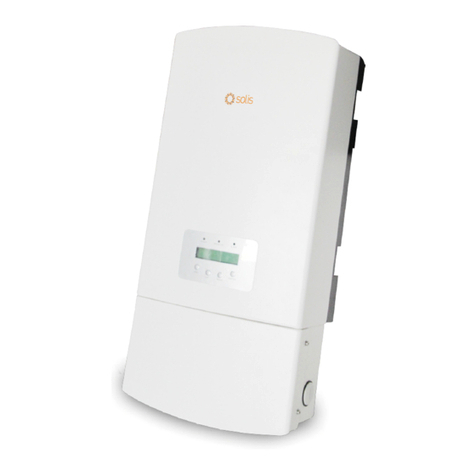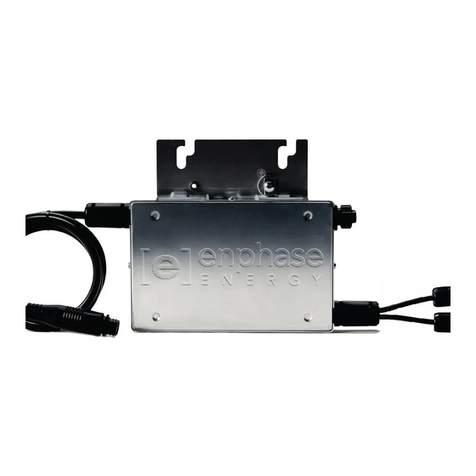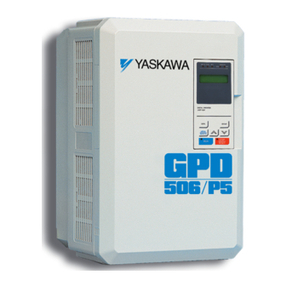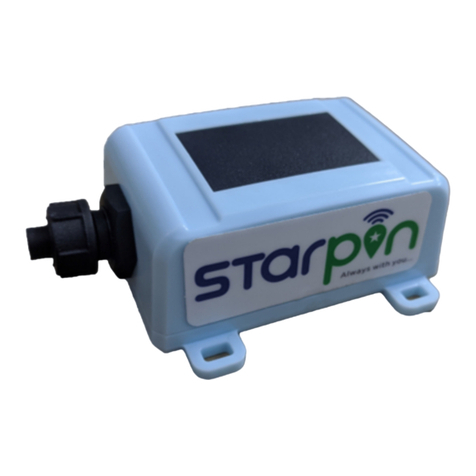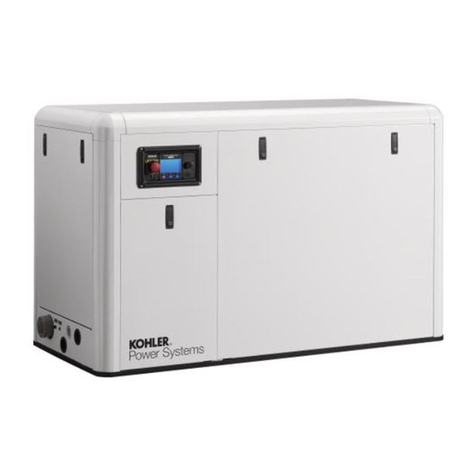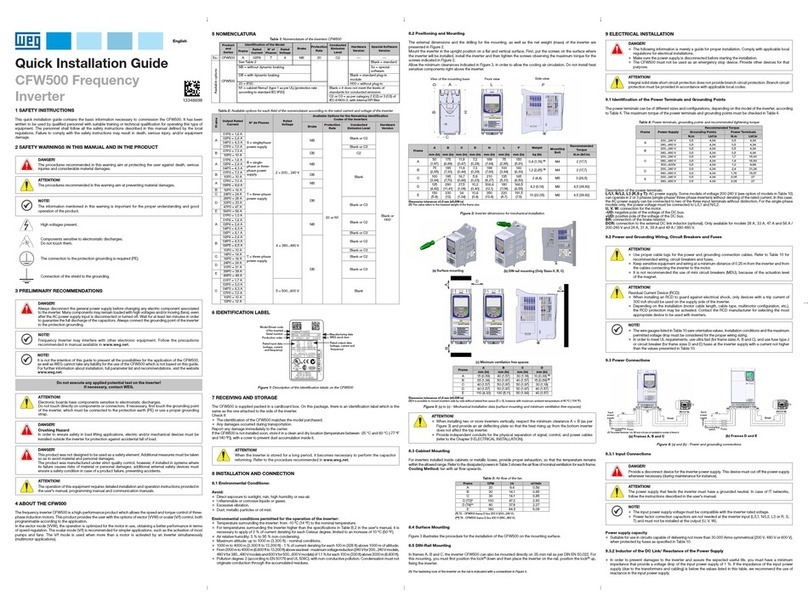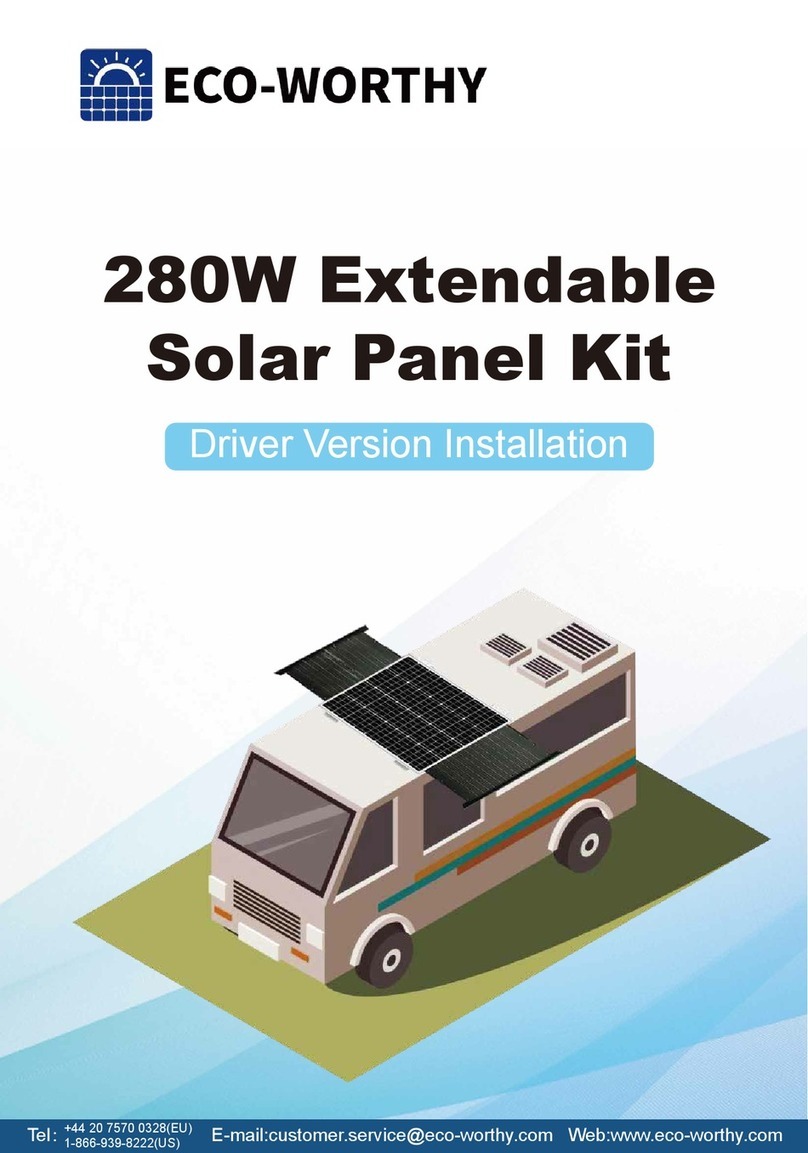K&S BASIC KS 2200A User manual

Please, read this manual
carefully before use!
OWNER’S MANUAL
Gasoline Powered Generator
KS 1200C
KS 2200A
KS 2200C
KS 2800A
KS 2800C
ENG

1
TABLE OF CONTENTS
1. PREFACE 2
2. SAFETY PRECAUTIONS 2
2.1. Work area 2-3
2.2. Electrical Safety 3
2.3. Personal Safety 3-4
2.4. Safety Precautions for Gasoline Powered Generator Operation 4
3. SAFETY SYMBOLS 5
3.1. Description of safety symbols when operating the generator 5
4. DESCRIPTION OF GENERATOR INSCRIPTIONS 6
5. GENERAL VIEW AND COMPOSITION
OF THE GASOLINE POWERED GENERATOR 7
6. GENERATOR SPECIFICATIONS 8-9
7. GENERATOR DELIVERY PACKAGE 10
8. CONTROL PANELS 10
9. COMMISSIONING 11
10. GETTING STARTED 11
10.1. Checking the fuel level 11
10.2. Checking the oil level 11
11. ENGINE START 12
11.1. Gasoline Powered Generator Engine Start 12
12. ENGINE STOP 13
12.1. Gasoline Powered Generator Stop 13
13. MAINTENANCE 13
14. RECOMMENDED MAINTENANCE SCHEDULE 14
15. SPARK PLUG MAINTENANCE 14
16. RECOMMENDED OILS 15
17. AIR FILTER MAINTENANCE 16
18. GENERATOR STORAGE 17
19. GENERATOR TRANSPORTATION 17
20. GENERATOR DISPOSAL 17
21. TROUBLESHOOTING 18
22. AVERAGE POWER RATINGS OF DEVICES 19
WARRANTY PROVISIONS 20

2
ABBREVIATIONS
KS -K&S Basic electric generator
А- Aluminum alternator winding
С- Copper winding
Please read this manual carefully. Pay particular attention to information that
starts with characters/words:
Failure to observe the recommendation indicated by this sign may result in
serious injury or death to the operator or unauthorized persons.
Useful information on the use of the device.
! !
WARNING - DANGER!
! !
PLEASE NOTE!
1. PREFACE
Thank you for your purchase of K&S Basic generator. This owner’s manual
contains safety instructions, a description of the use and commissioning of K&S
Basic generators and procedures for their maintenance.
The generator manufacturer may make some modications that may not be
reected in this manual. The manufacturer reserves the right to make changes
in the product design, conguration and construction. The images and drawings
in this manual are for reference only and may dier from the actual components
and inscriptions on the products.
Contact information that you are free to use in case of any problems can be found
at the end of this manual. All information in this manual is correct to the best of
our knowledge and belief at the date of its publication.The current list of service
centers can be found on the ocial importer's website: www.ks-power.de/en
Please read this manual carefully before rst in order to ensure
equipment integrity and avoid possible injuries.
! !
WARNING - DANGER!
2. SAFETY PRECAUTIONS
2.1. WORK AREA
- The generator must not be used in premises with poor ventilation since exhaust
gases contain poisonous carbon monoxide, which is life threatening!
- Do not use the generator in the rain, snow and high humidity. Do not touch
the generator with wet hands and expose to direct sunlight for a long time. It

3
is recommended to store and use the generator indoors or in well-ventilated
premises.
- Always install the generator on a at solid horizontal surface. The generator is
equipped with dampers to reduce vibration during operation and avoid damage to
the surface where the generator is installed.
- Do not use the generator near ammable gases, liquids or dust. During operation
of the generator, its exhaust system becomes very hot. This may cause re or
explosion of these materials.
- Keep the work area clean and well lit to avoid injuries.
- Keep unauthorized persons, children and animals away from the running
generator.
- Always wear protective shoes and protective gloves when operating the
generator.
2.2. ELECTRICAL SAFETY
- The wiring diagram for the generator must comply with the installation
rules and applicable statutory requirements.
- All wiring connections of the generator must be carried out by a certied
electrician in accordance with all electrical codes and regulations.
- Avoid the generator supply from the mains during restoration of the power
supply.
- Avoid operating the generator in high-humidity environments. Do not allow
moisture to enter the generator, as this increases the risk of electric shock.
- Avoid direct contact with grounded surfaces (pipes, radiators, etc.).
- Be careful when working with the power cord. Replace it immediately in
case of damage, as damaged power cord increases the risk of electric shock.
- All connections of the generator to the mains must be carried out by a
certied electrician.
- Connect the electric generator to the protective ground before operation
using the terminal located on the generator control panel.
- Do not connect/disconnect the generator to/from power consumers while
standing in water, on wet or damp soil.
- Do not touch live parts of the generator.
- Only connect the generator to the power consumers that correspond to the
electrical specications and power rating of the generator.
- Keep all electrical equipment dry and clean. Replace damaged or worn
wiring.Worn, damaged, or rusted terminals must be replaced as well.
2.3. PERSONAL SAFETY
- Do not operate the generator when you are tired or under the inuence of potent
drugs, alcohol or medication. During operation, inattention can cause serious injury.
- Avoid inadvertent start-up. Make sure the power switch is set to OFF when turning
o the generator.
! !
УВАГА - НЕБЕЗПЕЧНО!
The device generates electricity. Observe safety precautions to
avoid electric shock.

4
- Do not operate the generator in areas with poor ventilation. Exhaust gases contain
poisonous carbon monoxide, which is life threatening!
- Make sure there are no foreign objects on the generator when it is turned on. Use
the product for its intended purpose only. The generator customer using the device for
other than the intended purpose shall be deprived of the right to free warranty repair.
Do not sit, stand on the generator and misuse the equipment.
- Always keep proper footing and balance when starting the generator.
- Do not overload the generator, use it for its intended purpose only.
2.4. SAFETY PRECAUTIONS FOR GASOLINE POWERED GENERATOR OPERATION
Please note the following:
- Do not start the generator when it is under load.
- The generator must be installed at least 1 m away from explosive and ammable
substances and objects since its engine heats up during operation.
- Do not ll the fuel tank when the engine is running.
- Do not smoke while refueling.
- For the generator, A-92 gasoline is recommended. After lling the tank, remove all
excess fuel from the surface. Do not use kerosene or other fuel. Otherwise, the engine
may be damaged.
- Observe the fuel tank while lling in order to avoid overlling.
- Do not touch the exhaust system after starting the generator and during its
operation.
- Avoid operating the generator near water, in the rain or snow if there is a risk of it
becoming wet.
- Before starting the generator, learn how to stop the generator in case of an
emergency.
! !
WARNING - DANGER!
Failure to comply with these requirements may result in re or explosion of
the generator, as well as re in the building wiring.
Fuel pollutes soil and groundwater. Avoid gasoline leaking out
of the fuel tank!
! !
WARNING - DANGER!

5
Fig. 1
Fig. 2
3.
SAFETY SYMBOLS
3.1. DESCRIPTION OF SAFETY SYMBOLS WHEN OPERATING THE GENERATOR
a b c d
e f g h
a. Be careful when operating the device! Observe
the safety instructions in this manual.
b. Operate the generator only in well-ventilated
indoor spaces or outdoors. Exhaust gases contain
СО2, whose vapors are life threatening.
c. Do not operate or store the device in high-
humidity environments.
d. Do not smoke while operating the generator!
e. The device generates electricity. Observe
safety precautions to avoid electric shock.
f. Read this owner’s manual carefully before
operating the device.
g. Do not touch the generator with wet or dirty
hands.
h.Observe re safety regulations, do not operate
the generator near open ame.
i. Do not touch! The generator dampener
becomes hot during operation.
1
2
i
1 2

6
4. DESCRIPTION OF GENERATOR
INSCRIPTIONS
APART FROM THE SAFETY SYMBOLS, THE GENERATOR CONTAINS THE FOLLOWING
INSCRIPTIONS:
Recommended oils.
Crankcase capacity
(varies from model to model)
Specications chart. Specications vary
frommodel tomodel.Formore information,
see“Generator Specications”.
Indicates the position of the fuel valve. The“ON” position means
open and the“OFF”position means closed.
Indicates the direction of opening the air
choke.
Fuel level indicator. The icon on the left
indicates that the fuel tank is full, and the
icon on the right indicates that the fuel tank
is empty.
Maintenance information in the language of the country where the generator is
sold can be found in the“Maintenance”section.
Note on the required
oil level in the crankcase Ground
Noise level information for each model can be found in the
specications chart.

7
1. Fuel cap
2. Control panel
3. Oil dipstick
4. Oil drain cap
5. Hand starter
6. Fuel valve
7. Air lter
8. Air choke lever
9. Fuel level indicator
10. Damper
11. Alternator
12. Spark plug
5. GENERAL VIEW AND COMPOSITION OF
THE GASOLINE POWERED GENERATOR
Fig. 3
! !
PLEASE NOTE!
2
1
3
4
5
6
7
8
9
12
10
11
The manufacturer reserves the right to make changes in the product
design, conguration and construction. Illustrations in this manual
are for reference only and may dier from actual components and
inscriptions on the products.

8
6.
GENERATOR SPECIFICATIONS:
Model KS 1200C KS 2200A KS 2200C
Voltage (V) 230 230 230
Maximum power (kW/kVA) 1,0/1,0 2,2/2,2 2,2/2,2
Rated power (kW/kVA) 0,9/0,9 2,0/2,0 2,0/2,0
Frequency (Hz) 50 50 50
Current (A) 4,35 9,57 9,57
Outlets 2*16А 2*16А 2*16А
Fuel tank capacity (L) 6 15 15
Operation time at 50% load 9 13 13
Voltmeter + + +
Noise level LWA (dB) 95 95 95
Output 12 V (A) 12/8,3 12/8,3 12/8,3
Engine model KS-B80 KS-B170 KS-B170
Engine type Gasoline
powered
four-stroke
Gasoline
powered
four-stroke
Gasoline
powered
four-stroke
Power output (hp) 2,9 5,5 5,5
Crankcase capacity (cm3) 0,37 0,6 0,6
Engine capacity (cm3) 80 163 163
Voltage regulator AVR AVR AVR
Engine start Manual Manual Manual
Power factor (cosφ) 1 1 1
Dimensions (LxWxH), mm 470*365*380 605*445*450 605*445*450
Net weight (kg) 26 40 40
Protection class IP23M IP23M IP23M
Max. altitude above sea level (m) 1000 1000 1000
Relative humidity <30% <30% <30%
Rated voltage tolerance - max. 5%

9
Model KS 2800A KS 2800C
Voltage (V) 230 230
Maximum power (kW/kVA) 2,8/2,8 2,8/2,8
Rated power (kW/kVA) 2,5/2,5 2,5/2,5
Frequency (Hz) 50 50
Current (A) 12,7 12,7
Outlets 2*16А 2*16А
Fuel tank capacity (L) 15 15
Operation time at 50% load 12 12
Voltmeter + +
Noise level LWA (dB) 96 96
Output 12 V (A) 12/8,3 12/8,3
Engine model KS-B200 KS-B200
Engine type
Gasoline
powered
four-stroke
Gasoline
powered
four-stroke
Power output (hp) 6,5 6,5
Crankcase capacity (cm3) 0,6 0,6
Engine capacity (cm3) 196 196
Voltage regulator AVR AVR
Engine start Manual Manual
Power factor (cosφ) 1 1
Dimensions (LxWxH), mm 605*445*450 605*445*450
Net weight (kg) 43 43
Protection class IP23M IP23M
Max. altitude above sea level (m) 1000 1000
Relative humidity <30% <30%
Rated voltage tolerance - max. 5%

10
8. CONTROL PANEL
Fig. 4
1. Voltmeter
2. Safety switch
3. Outlets
4. Engine start button (ON/OFF)
5. 12 V/DC sockets
6. Ground connector
123
654
7. GENERATOR DELIVERY PACKAGE
1. Generator
2. Packaging
3. Owner's manual
4. Spark plug wrench
USE CARE WHEN THE GENERATOR IS RUNNING:
- You can use the generator if the voltmeter indicates a value of 230 V ±10%
(50 Нz).
- Monitor the voltmeter and stop the generator if the value is too high.
- Avoid using 12V voltage simultaneously with 230 V.

11
10. GETTING STARTED
10.1. CHECKING THE FUEL LEVEL
1. Wear protective gloves to avoid getting gasoline on your skin.
2. Unscrew the fuel cap and check the fuel level in the tank.
3. Fill the fuel tank to the fuel lter level.
4. Tighten the fuel cap securely.
9. COMMISSIONING
The generator is supplied without fuel. Before use, be sure to ll the fuel tank.
Recommendations for refueling are listed below. The generator is supplied
without motor oil. The generator crankcase may contain oil residues after
factory tests. Be sure to add oil before use. Recommendations for oils and lling
procedure are given below.
To commission the generator, follow the maintenance recommendations for the
rst month or twenty hours of operation (whichever comes rst) contained in
the“Maintenance”section.
Fig. 5
Fig. 6
10.2. CHECKING THE OIL LEVEL
1. Wear protective gloves to avoid getting oil on
your skin.
2. Unscrew the oil dipstick and wipe it out with a
clean cloth.
3. Insert the dipstick without screwing it in.
4. Check the oil level by a mark on the oil dipstick.
5. Add oil if its level is below the mark on the oil
dipstick.
6. Tighten the oil dipstick.
For the generator, A-92 gasoline is recommended. Using other fuels may
cause damage to the engine.
! !
PLEASE NOTE!
! !
PLEASE NOTE!
If the generator has not been used for a long time, recharge the
battery with a charger (not included).
Fuel cap

12
11. ENGINE START
Before starting the engine make sure that the total power of tools or
power consumers corresponds to the rated power of the generator.
Do not exceed the rated power of the generator. Do not connect
any devices before the engine start! In the power supply mode, the
generator should operate no longer than 30 minutes in the range
from rated to maximum power.
11.1. GASOLINE POWERED GENERATOR ENGINE START
1. Move the fuel valve to the“OPEN”position.
2. Set the air choke to the closed position.
3. To start the generator manually, grasp the starter handle and slowly pull
it until resistance is felt. Pull the starter cord to the full length with a sharp
movement.
4. Set the air choke to the“OPEN”position.
Before connecting any devices to the generator, make sure that they are in
good condition. If the device that was connected suddenly stopped or failed,
immediately disconnect the power using a safety switch, disconnect the device
and check it out.
Do not connect two or more devices simultaneously. The start-up
of many devices requires high power. Devices should be connected
in turn according to their power rating. Do not connect any power
consumers within the rst 3 minutes after the generator start.
! !
WARNING - DANGER!
! !
WARNING - DANGER!
Fuel valve Fig. 7
Closed
Open Hand starter
Air choke
closed
OPEN
open CLOSE

13
12. ENGINE STOP
Disconnect all devices before stopping the generator! Do not stop the
generator if it has any devices connected to it. This may disable the
generator!
12.1. GASOLINE POWERED GENERATOR STOP:
1. Disconnect all power consumers from the generator, set the safety switch to
the OFF position.
2. In case of manual start, set the engine switch to OFF.
3. In case of electric start, set the key to OFF.
4. Move the fuel valve to the“CLOSE”position.
5. Allow the generator to operate at idle for 3 minutes so that the alternator
cools down.
! !
PLEASE NOTE!
13. MAINTENANCE
Maintenance work listed in section "Maintenance" should be performed on a
regular basis. If you cannot perform maintenance work on your own, please
contact the authorized service center to request the required maintenance work.
The manufacturer shall not be liable for any damage caused by failure
to perform maintenance work.
Such damage also includes:
- Damage resulting from the use of non-original spare parts;
- Corrosive damage and other eects of improper storage of equipment;
- Damage caused by maintenance work performed by unskilled technicians.
The current list of service centers can be found on the exclusive importer's
website: www.ks-power.com.ua. Main service center: Kyiv, 47 Elektrotekhnichna
Str., Tel.: (096) 967 43 31, (050) 147 35 39, (093) 100 06 47.
Observe the instructions in this manual!
! !
PLEASE NOTE!
The generator must be maintained, operated and stored in accordance with the
instructions in this manual.The manufacturer shall not be liable for damage and
loss caused by failure to comply with safety and maintenance regulations.
This primarily applies to:
- The use of lubricants, fuels and motor oils not authorized by the manufacturer;
- Technical changes to the product;
- The misuse of equipment;
- Indirect losses caused by operation of the product with defective parts.

14
14. RECOMMENDED MAINTENANCE
SCHEDULE
Node
Service type
First month
or 20 hours
Before starting
Each month or after
20 working hours
Each 3 months or
after 50 working hrs
Each 6 months or
after 100 working hrs
Each year or after
300 working hrs
Motor
oil
Checking
level
V
Changing
V V
Air
lter
Cleaning
V V
Changing
V
Sparking
plug
Cleaning
V V
Changing
V
Fuel
tank
Checking
level
V
Cleaning
V
Fuel
lter Cleaning
V
15. SPARK PLUG MAINTENANCE
A spark plug is an important element that ensures proper engine operation. It
must be intact, properly gapped and free of deposits.
Inspecting the spark plug:
1. Remove the spark plug cap.
2. Unscrew the spark plug with the appropriate wrench.
3. Visually inspect the spark plug. If the spark plug is damaged, it must be
replaced. It is recommended to use the F7TC spark plug.
4. Measure the gap. It should be in the range of 0.7 – 0.8 mm.
5. Before re-using the spark plug, it must be cleaned from deposits with a metal
brush. After that, set the correct gap.
6. Screw in the spark plug back with the dedicated spark plug wrench.
7. Replace the spark plug cap.
Fig. 8 Fig. 9
Spark plug 0,60 - 0,80 мм
Electrodе

15
16. RECOMMENDED OILS
Motor oil signicantly aects the engine performance and is the main factor that
determines its service life. Use oil intended for four-stroke automobile engines,
as it contains detergent additives that meet or exceed the SE standards according
to the APE classication (or equivalent). Generally, it is recommended to use oil
with a viscosity of SAE 10W-30. Motor oils with a dierent grade shown in the
table can be used only if the average air temperature in your area does not fall
outside the specied temperature range. SAE oil viscosity or oil service category
is indicated on the APE tank label.
REPLACING OR ADDING MOTOR OIL
If the oil level drops, fresh oil must be added to ensure proper operation of the
generator. Check the oil level according to the maintenance schedule.
To drain oil, proceed as follows:
1. Wear protective gloves to avoid getting oil on your skin.
2. Place an oil drain tray under the engine.
3. Unscrew the drain cap located on the engine under the dipstick cap with a
10 mm wrench (for generators up to 3.0 kW) or 12 mm (for generators above
3.0 kW).
4. Wait for the oil to drain.
5. Replace the drain cap and tighten securely.
6. It is better to drain oil while the engine is still hot after operation to ensure
quick and complete oil draining.
To add oil, proceed as follows:
1. Wear protective gloves to avoid getting oil on your skin.
2. Make sure the generator is mounted on a at, level surface.
3. Unscrew the dipstick cap on the engine.
4. Use a funnel to ll the crankcase with high-grade oil. The funnel is not
included. After lling, the oil level should be close to the top of the oil ller.
-20 -10 0 10 20 30 40 0C
5W-30, 10W-30
Fig. 10
Drain cap
Dipstick cap
Fill to here

16
17.
AIR FILTER MAINTENANCE
The air lter should be checked for contamination from time to time. Regular
maintenance of the air lter is necessary to maintain sucient air ow in the
carburetor.
Cleaning the lter
1. Open the clips on the top cover of the air lter.
2. Remove the sponge lter element.
3. Remove all dirt inside the empty air lter housing.
4. Clean the lter element thoroughly in warm soapy water.
5. Dry the sponge lter.
6. Soak a dry lter element in engine oil, and then squeeze out excess oil.
Replace the air lter every 50 operating hours of the generator
(every 10 hours in dirty conditions).
Cover spring
Cover spring
Clean Squeeze outSoakSqueeze out
Filter
Air lter cover
21 43
Fig. 11
! !
PLEASE NOTE!
Oil pollutes soil and groundwater. Avoid oil leaking out of the
crankcase. Dump used oil into the sealed container.
Hand over used oil to waste oil collection point.
! !
WARNING - DANGER!

17
18. GENERATOR STORAGE
The generator must be stored in a dry, well-ventilated area that is free from dust.
Keep away from children and animals. It is recommended to store and use the
generator at a temperature of -20 to +40 °C. Do not expose the generator to
direct sunlight and precipitation.
19. GENERATOR TRANSPORTATION
For convenient transportation of the generator, use the original packaging of
the generator. Secure the generator packaging to prevent the generator from
tipping over during transportation. Before transporting the generator, drain the
fuel and disconnect the battery terminals.
To lift or handle the generator on site, grasp it by the frame. Be careful when
handling the heavy generator (40 to 90 kg). It is recommended that the
generator be carried by at least two people. Move carefully, do not put your feet
under the generator frame.
Note! The generator must always be ready for use. Any malfunctions
in the generator must be repaired before placing the generator in
storage.
In case of lengthy generator downtime, observe the following
conditions:
- External parts of the generator and engine, especially cooling ns, must be
thoroughly cleaned.
- Unscrew the carburetor oat chamber screw, empty the chamber.
- Remove the spark plug.
- Unscrew the oil drain screw and drain the oil.
- Add a teaspoon of engine oil (5 – 10 ml) to the cylinder. After that, pull the
starter cord several times so that the oil spreads along the cylinder walls.
- Replace (screw in) the spark plug.
- Pull the starter handle until resistance is felt so that the piston is at the top of
its stroke. As a result, the inlet and outlet valves of the generator will be closed
and no internal corrosion of the engine will occur if the device is stored in that
position.
- Release the starter handle smoothly.
- Remove the battery terminals. Grease the battery and connection terminals
with anti-oxidation grease.
Before long-term storage of the generator when the engine is
running, close the fuel valve of the fuel tank and allow the engine to
work gasoline out of the carburetor. Wait until the engine stops.
! !
PLEASE NOTE!
! !
PLEASE NOTE!
20. GENERATOR DISPOSAL
To prevent damage to the environment, do not dispose of the generator in normal
household waste. Dispose of the generator in the safest way by handing it over to
dedicated waste collection points.

18
21.TROUBLESHOOTING
Fault Probable cause Remedy
Engine will not
start
The engine start key (button)
is set to the OFF position
Set the engine start key
(button) to the ON position
Thefuel valveissettothe“CLOSE”
position
Move the fuel valve to the
“OPEN”position
Air choke is open Close the air choke lever
Fuel tank is empty Fill in the fuel tank
Fuel tanks contains dirty or
used fuel Replace fuel in the fuel tank
Spark plug smoked or
damaged; wrong distance
between electrodes
Clean the spark plug or
replace it with a new one; set
the correct distance between
the electrodes
Reduced engine
power / troubled
engine start
Fuel tank is dirty Clean the fuel tank
Air lter is dirty Clean the air lter
Water in fuel tank and/
or carburetor; clogged
carburetor
Empty the fuel tank, fuel line
and carburetor
Wrong distance between
spark plug electrodes
Set the correct distance
between the electrodes.
Engine overheating Cooling ns are contaminated Clean the cooling ns
Air lter is dirty Clean the air lter
Engine starts, but
no output voltage
Circuit breaker tripped Set the circuit breaker to ON
Connection cables of poor
quality
Check cables for normal
operation; replace, if
extension cable is used
Faulty connected device Try connecting another
device
Generator works,
but does not support
connected electrical
devices
Device overload Try to connect less equipment
Short circuit of one of the
connected devices
Try disconnecting the faulty
device.
Air lter is dirty Clean the air lter
Insucient engine speed Contact the service center

19
22. AVERAGE POWER CONSUMPTION OF
DEVICES
Device Power (kW)
Iron 500-1100
Hair dryer 450-1200
Coee machine 800-1500
Electric cooker 800-1800
Toaster 600-1500
Heater 1000-2000
Vacuum cleaner 400-1000
Radio 50-250
Grill 1200-2300
Oven 1000-2000
Fridge 100-150
TV set 100-400
Perforator 600-1400
Drill 400-800
Freezer 100-400
Grinder 300-1100
Circular saw 750-1600
Crank gear 650-2200
Jigsaw 250-700
Planer 400-1000
Compressor 750-3000
Water pump 750-3900
Bench saw 1800-4000
Electric mower 750-3000
Electric motors 550-5000
Fans 750-1700
High pressure unit 2000-4000
Air conditioner 1000-5000
This manual suits for next models
4
Table of contents
Other K&S BASIC Inverter manuals
Popular Inverter manuals by other brands

Airpax Dimensions
Airpax Dimensions MIL-24/2600Q owner's manual

FujiFilm
FujiFilm FU-SUN-15K-G03 user manual
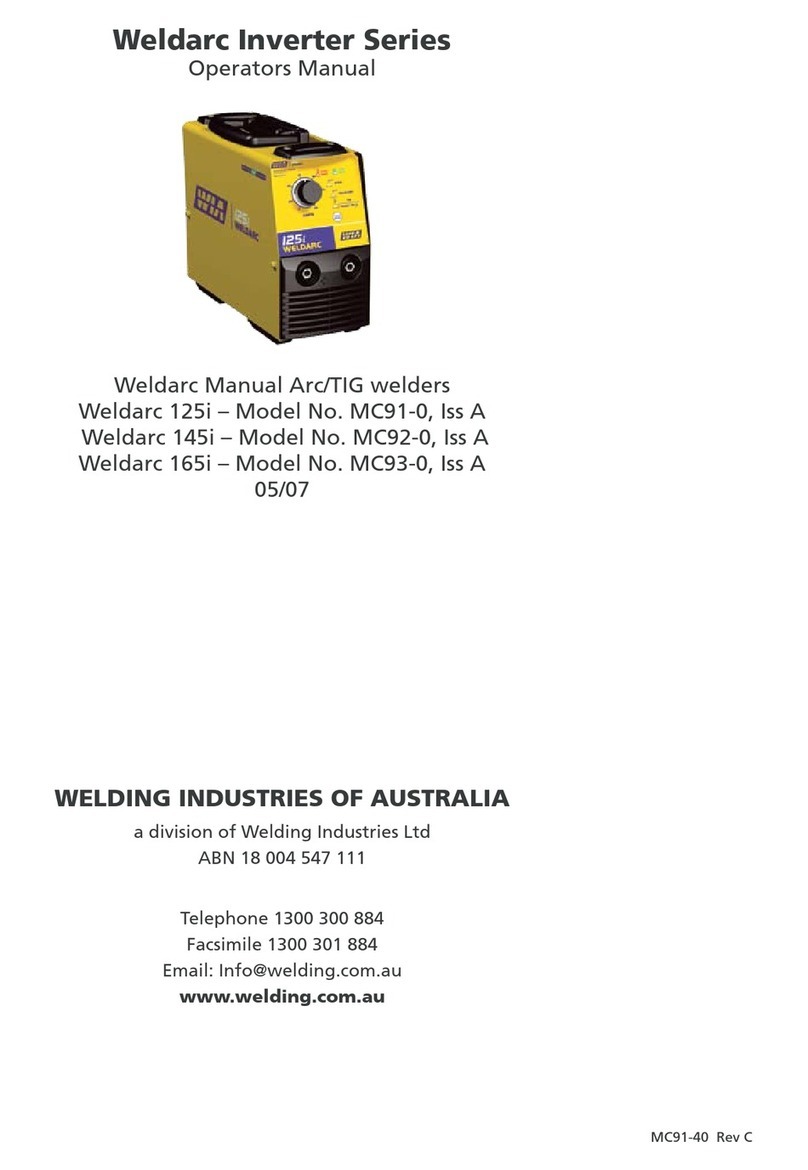
WELDING INDUSTRIES
WELDING INDUSTRIES 125i MC91-0 Operator's manual
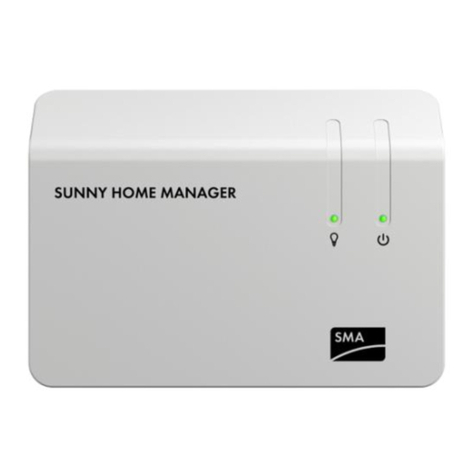
SMA
SMA sunny home manager installation manual
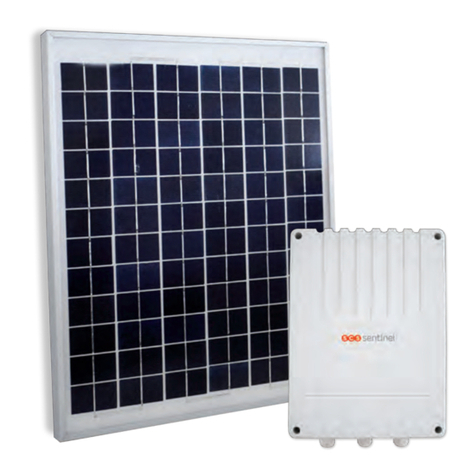
SCS Sentinel
SCS Sentinel SolarGate AAM0095 Installation and user manual
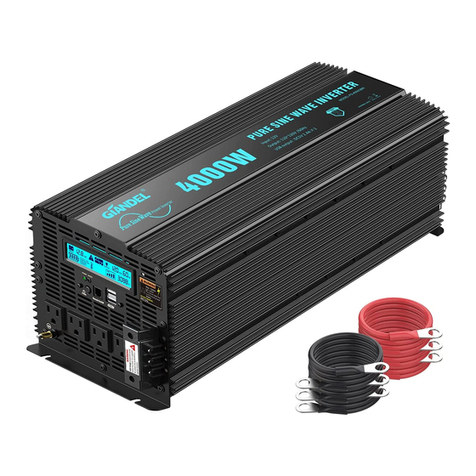
Giandel
Giandel PS-3000QBR user manual

